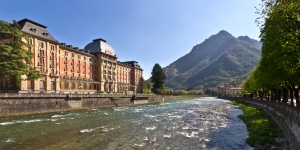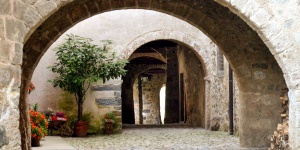The Brembana Valley cycle path is a cycle and pedestrian route that goes up the valley from Zogno (a town about 20km from Bergamo) to Piazza Brembana. The route follows the old railway line, in use until the 1960s, almost the entire way, with extraordinary views of the Brembo river between sheer rock walls.
The cycle path is paved and therefore accessible with any bicycle and, on some stretches, is divided into two lanes. Along the way there are several tunnels that automatically light up as you pass through. However, it is advisable to also bring a light with you. The tunnels near Cornello dei Tasso are particularly fascinating, illuminated from below to highlight the live rock of the vaults.
The cycle path passes through historic noteworthy sites (that are worth a stop!):
The cycle route is frequented by families, cyclists and cycle-hikers. Suitable for everyone, you just have to try it!
Route information:
Departure point: Zogno, Piazza Genieri d’Italia
Arrival point: Piazza Brembana, via Antonio Locatelli
Travel time: 2 hours (one way)
Length: 22km.
On cycle path: 85%
Ground: asphalt: 95%, dirt: 5%,
Total change in altitude: 230m
Minimum altitude: 315m
Maximum altitude: 521m
Practicability: All year, very busy on Sundays in summer
Suitable for: Adults and children with some caution along the short stretches on the ordinary road (some short stretches of low-traffic road are in San Pellegrino Terme, San Giovanni Bianco and Camerata Cornello)
The Brembana Valley cycle path is a cycle and pedestrian route that goes up the valley from Zogno (a town about 20km from Bergamo) to Piazza Brembana. The route follows the old railway line, in use until the 1960s, almost the entire way, with extraordinary views of the Brembo river between sheer rock walls.
The cycle path is paved and therefore accessible with any bicycle and, on some stretches, is divided into two lanes. Along the way there are several tunnels that automatically light up as you pass through. However, it is advisable to also bring a light with you. The tunnels near Cornello dei Tasso are particularly fascinating, illuminated from below to highlight the live rock of the vaults.
The cycle path passes through historic noteworthy sites (that are worth a stop!):
The cycle route is frequented by families, cyclists and cycle-hikers. Suitable for everyone, you just have to try it!
Route information:
Departure point: Zogno, Piazza Genieri d’Italia
Arrival point: Piazza Brembana, via Antonio Locatelli
Travel time: 2 hours (one way)
Length: 22km.
On cycle path: 85%
Ground: asphalt: 95%, dirt: 5%,
Total change in altitude: 230m
Minimum altitude: 315m
Maximum altitude: 521m
Practicability: All year, very busy on Sundays in summer
Suitable for: Adults and children with some caution along the short stretches on the ordinary road (some short stretches of low-traffic road are in San Pellegrino Terme, San Giovanni Bianco and Camerata Cornello)
The cycle path starts in Zogno, in the large market car park on the banks of the Brembo river (piazza Genieri d’Italia). Beyond the bridge the paved cycle path begins (pic1) that runs along the SS470 state road on one side and the Brembo river on the other. Once in the Acquada area you will come across the first of a series of characteristic art nouveau Railway Stations.
Follow the underpass and the pedestrian bridge, turn left: you will find yourself on the left bank of the Brembo river. On the opposite bank, you will see the San Pellegrino factory whose mineral waters are famous throughout the world.
Now ride for a short stretch on the road and, after crossing a small square in the middle of a neighbourhood of houses, you will shortly reach San Pellegrino Terme station (pic2).
At this point, a stop is a must to visit the beautiful spa town dating back to the Belle Époque.
The cycle path starts in Zogno, in the large market car park on the banks of the Brembo river (piazza Genieri d’Italia). Beyond the bridge the paved cycle path begins (pic1) that runs along the SS470 state road on one side and the Brembo river on the other. Once in the Acquada area you will come across the first of a series of characteristic art nouveau Railway Stations.
Follow the underpass and the pedestrian bridge, turn left: you will find yourself on the left bank of the Brembo river. On the opposite bank, you will see the San Pellegrino factory whose mineral waters are famous throughout the world.
Now ride for a short stretch on the road and, after crossing a small square in the middle of a neighbourhood of houses, you will shortly reach San Pellegrino Terme station (pic2).
At this point, a stop is a must to visit the beautiful spa town dating back to the Belle Époque.

They say that San Pellegrino is “the gem of the Brembana Valley”, and it is, indeed! The art nouveau palaces, the historical spa with the thermal baths, the San Pellegrino plant, renowned all over the world for its mineral water and beverages: and there’s so much more!
The Thermal Baths were built in 1840 and turned a small village of the valley into an outstanding holiday resort for the wealthy international middle class. The health spa was enlarged at the end of the XIX Century with some buildings in art nouveau style, called “Liberty”, the artistic trend featuring curve lines and arabesques. In just a few years, this art movement captivated the whole village of San Pellegrino, enriching it with some of the finest examples of Liberty style, including the majestic Casino, the Grand Hotel and the water bottling factory.
Most of these buildings can still be visited; some of them have been recently restored and opened back to the public. The Spa, for instance, now belongs to an elegant wellness centre combining the Liberty architecture with a contemporary and elegant design.
After passing the San Pellegrino Terme power plant and going through the first tunnel at the crossroads, keep left before and after taking two other tunnels (pic3) (pic4). You will then arrive in San Giovanni Bianco. Here you will have to ride on a stretch of road but, after passing the carpark and an alternating one-way tunnel, you will immediately resume the cycle path (pic5).
The road with long straight stretches in the woods begins to head up the valley and to your right you can see the hydroelectric power station which in the past provided energy to the railway line.
Having ridden through some enchanting tunnels dug into the rock you reach the houses of Camerata Cornello, a town that houses one of the most beautiful villages in Italy: Cornello dei Tasso.
Here, too, a stop is more than recommended. With a short detour (1.5km uphill by road), you can immerse yourself in a medieval village that has remained intact over time.
After passing the San Pellegrino Terme power plant and going through the first tunnel at the crossroads, keep left before and after taking two other tunnels (pic3) (pic4). You will then arrive in San Giovanni Bianco. Here you will have to ride on a stretch of road but, after passing the carpark and an alternating one-way tunnel, you will immediately resume the cycle path (pic5).
The road with long straight stretches in the woods begins to head up the valley and to your right you can see the hydroelectric power station which in the past provided energy to the railway line.
Having ridden through some enchanting tunnels dug into the rock you reach the houses of Camerata Cornello, a town that houses one of the most beautiful villages in Italy: Cornello dei Tasso.
Here, too, a stop is more than recommended. With a short detour (1.5km uphill by road), you can immerse yourself in a medieval village that has remained intact over time.

Visiting Cornello dei Tasso, in the district of Camerata Cornello, is like making a journey to the Middle Age. This hamlet, named one of the most beautiful in Italy, stands on a spur overlooking the Brembo River. You can reach it in only two ways: walking or using the mule tracks, the old dirt roads. The village’s isolation also represented its biggest fortune, as it allowed it to keep intact the entire ancient urban layout.
However, there’s so much more to explore in Cornello: in the “Museo dei Tasso e della Storia postale – the Tassos and the Postal Service History Museum” you will find many written documents related to the activity of the noble and ancient Tasso family, from Cornello, which played a crucial role in the communication field all over Europe, inventing the postal service and the taxi, as well. Don’t miss the renowned Penny Black, the first stamp ever issued!
Finally, crime also features Camerata Cornello’s history…in the early XX Century one of its inhabitants committed a brutal massacre. Keep reading to learn more!
From Camerata Cornello take the road that runs parallel to the Brembo river, pass next to the Church of the Dead built close to the rock (pic6) and continue on the path again going up to the left (pic7). After a straight stretch parallel to the road but protected by a guard-rail (pic8) you reach a small carpark where you go to the right over the iron bridge that crosses the Brembo (pic9) and passes next to the Agriturismo Ferdy with the attached "baita dei ciclisti - cyclists' hut", a great place to eat if you want to take a break (pic10).
Continue to the bridge of the goats, a fifteenth century stone bridge with the typical humpback form, cross it (pic11), go to the right and, after a long bridge, (pic12) you will find yourself pedaling next to some beautiful meadows. Here it is possible to stop at a kiosk with a bar before tackling the last section of the cycle path.
Now the cycle path takes you slightly uphill to make a wide turn to the left and, after the tunnel, you will arrive at Piazza Brembana. The arrival point of the route is in a park next to the bus station, once a railway station.
A break is more than deserved once getting to the end! Rest in the village or in the park in the centre where there is shade and a fountain for water (pic13) before facing the return to Zogno.
From Camerata Cornello take the road that runs parallel to the Brembo river, pass next to the Church of the Dead built close to the rock (pic6) and continue on the path again going up to the left (pic7). After a straight stretch parallel to the road but protected by a guard-rail (pic8) you reach a small carpark where you go to the right over the iron bridge that crosses the Brembo (pic9) and passes next to the Agriturismo Ferdy with the attached "baita dei ciclisti - cyclists' hut", a great place to eat if you want to take a break (pic10).
Continue to the bridge of the goats, a fifteenth century stone bridge with the typical humpback form, cross it (pic11), go to the right and, after a long bridge, (pic12) you will find yourself pedaling next to some beautiful meadows. Here it is possible to stop at a kiosk with a bar before tackling the last section of the cycle path.
Now the cycle path takes you slightly uphill to make a wide turn to the left and, after the tunnel, you will arrive at Piazza Brembana. The arrival point of the route is in a park next to the bus station, once a railway station.
A break is more than deserved once getting to the end! Rest in the village or in the park in the centre where there is shade and a fountain for water (pic13) before facing the return to Zogno.